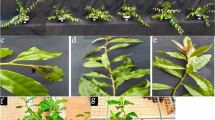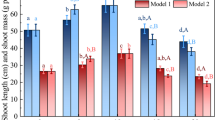Abstract
Selenium deficiency in various degrees affects around 15% of the world’s population, contributing to a variety of health problems. In this study, we examined the accumulation and biotransformation of soil applied Se-supplementation (sodium selenite and sodium selenate forms) at different concentrations, along with growth and yield formation of green pea, in a greenhouse experiment. Biotransformation of inorganic Se was evaluated using HPLC-ICP-MS for Se-species separation in the above ground parts of green pea. Results showed 3 mg kg−1 SeIV increased green pea growth biomarkers and also caused an increase in protein content in leaves by 17%. Selenomethionine represented 65% of the total selenium content in shoots, but was lower in pods and seeds (54 and 38%, respectively). Selenomethionine was the major species in all plant parts and the only organic selenium form in the lower SeIV concentration range. Elevating the dose of SeIV (≥30 mg kg−1) triggered detrimental effects on growth and protein content and caused higher accumulation of inorganic Se in forms of SeVI and SeIV. Selenocysteine, another organic form of proteinogenic amino acid, was determined when SeIV (≥10 mg kg−1) was applied in higher concentrations. Thus, agronomic biofortification using the appropriate chemical form and concentration of Se will have positive effects on green pea growth and its enriched shoots and seeds provide a value-added protein source for livestock and humans with significant increased selenomethionine.


Similar content being viewed by others
Abbreviations
- BSA:
-
Bovine Serum Albumin
- n:
-
Number
- Na2SeO3 :
-
Sodium selenite
- Na2SeO4 :
-
Sodium selenate
- s.e.:
-
Standard error
- SeIV:
-
Selenite
- SeVI:
-
Selenate
- SeCys2 :
-
Selenocysteine
- SeMet:
-
Selenomethionine.
References
Acikgoz E, Katkat V, Omeroglu S, Okan B (1985) Mineral elements and amino acid concentrations in field pea and common vetch herbages and seeds. J Agron Crop Sci 55:179–185
Amweg EL, Stuart DL, Weston DP (2003) Comparative bioavailability of selenium to aquatic organisms after biological treatment of agricultural drainage water. Aquat Toxicol 63:13–25. doi:10.1016/s0166-445x(02)00110-8
Behne D, Kyriakopoulos A, Kalcklösch M, Weiss-Nowak C, Pfeifer H, Gessner H et al (1997) Two new selenoproteins found in the prostatic glandular epithelium and the spermatid nuclei. Biomed Environ Sci 10(2–3):340–345
Birringer M, Pilawa S, Flohe L (2003) Trends in selenium biochemistry. Nat Prod Rep 19:693–718. doi:10.1002/chin.200314290
Bradford M (1976) A rapid and sensitive method for the quantitation of microgram quantities of protein utilizing the principle of protein-dye binding. Anal Biochem 72:248–254. doi:10.1016/0003-2697(76)90527-3
Carvalho SMP, Vasconcelos MW (2013) Producing more with less: strategies and novel technologies for plant-based food biofortification. Food Res Int 54:961–971. doi:10.1016/j.foodres.2012.12.021
Darnton-Hill IP, Webb PW, Harvey JM, Hunt N, Dalmiya M, Chopra et al (2005) Micronutrient deficiencies and gender: social and economic costs. Am J Clin Nutr 81:1198S–1205S
Dworkin BM (1994) Selenium deficiency in HIV infection and the acquired immunodeficiency syndrome (AIDS). Chem Biol Interact 91(2–3):181–186. doi:10.1016/0009-2797(94)90038-8
Eurola MH, Ekholm PI, Ylinen ME, Koivistoinen PE, Varo PT (1991) Selenium in Finnish foods after beginning the use of selenate supplemented fertilisers. J Sci Food Agric 56:57–70. doi:10.1002/jsfa.2740560107
FAO (2011) Faostat database. Economic and Social Development Department, Rome, Italy, 2011
Filek M, Gzyl-Malcher B, Zembala M, Bednarska E, Laggner P, Kriechbaum M (2010) Effect of selenium on characteristics of rape chloroplasts modified by cadmium. J Plant Physiol 167:28–33. doi:10.1016/j.jplph.2009.07.003
Filley SJ, Peters A, Bouska C, Pirelli G, Oldfield J (2007) Selenium fertilization of pastures for improved forage selenium content. J Anim Sci 23:144–147. doi:10.15232/s1080-7446(15)30954-2
Hajiboland R, Amjad L (2007) Does antioxidant capacity of leaves play a role in growth response to selenium at different sulfur nutritional status? Plant Soil Environ 53 (5):207–215
Hartikainen H (2005) Biogeochemistry of selenium and its impact on food chain quality and human health. J Trace Elem Med Biol 18:309–318. doi:10.1016/j.jtemb.2005.02.009
Kovács B, Győri Z, Prokisch J, Loch J, Dániel P (1996) A study of plant sample preparation and inductively coupled plasma emission spectrometry parameters. Commun Soil Sci Plant Anal 27:1177–1198. doi:10.1080/00103629609369625
Mikkelsen RL, Page AL, Bingham FT (1989) Factors affecting selenium accumulation by agricultural crops. In: Jacobs LW (ed) Selenium in agriculture and the environment. Proc Symp ASA –SSSA, New Orleans
Moreno RG, Burdock R, Álvarez MCD, Crawford JW (2013) Managing the selenium content in soils in semiarid environments through the recycling of organic matter. Appl Environ Soil Sci 2013:283468. doi:10.1155/2013/28346810 pages
Nagy K, Lévai L, Kovács B (2010) The effect of selenium supply on maize and sunflower. Növénytermelés 59:61–84
Pedrero Z, Madrid Y, Hartikainen H, Cámara C (2008) Protective effect of selenium in broccoli (Brassica oleracea) plants subjected to cadmium exposure. J Agric Food Chem 56:266–271. doi:10.1021/jf072266w
Poblaciones MJ, Sara M, Santamaría RO (2012) Evaluation of the potential of peas (Pisum sativum L.) to be used in selenium biofortification programs under Mediterranean conditions. Biol Trace Elem Res 151:132–137. doi:10.1007/s12011-012-9539-x
Polatajko A, Sliwka-Kaszynska M, Dernovies M, Ruzik R, Ruiz Encinar J, Szpunar J (2004) A systematic approach to selenium speciation in selenized yeast. J Anal At Spectrom 19:114–120. doi:10.1039/b308756p
Reilly C (1996) Biological role of selenium. Blackie, Selenium in food and health. London, pp 25–85. doi:10.1007/978-1-4757-6494-9_2
Spallholz JE, Boylan LM, Larsen HS (1990) Advances in understanding selenium's role in the immune system. Ann NY Acad Sci 587:123–139. doi:10.1111/j.1749-6632.1990.tb00140.x
Thavarajah D, Ruszkowski J, Vandenberg A (2008) High potential for selenium biofortification of lentils (Lens culinaris L.). J Agric Food Chem 56:10747–10753. doi:10.1021/jf802307h
Thavarajah D, Warkentin T, Vandenberg A (2010) Natural enrichment of selenium in Saskatchewan field peas (Pisum sativum L.). Can J Plant Sci 90:383–389. doi:10.4141/cjps09154
White PJ, Broadley MR (2009) Biofortification of crops with seven mineral elements often lacking in human diets — iron, zinc, copper, calcium, magnesium, selenium and iodine. New Phytol 182:49–84. doi:10.1111/j.1469-8137.2008.02738.x
Zhao FJ, McGrath SP (2009) Biofortification and phytoremediation. Curr Opin Plant Biol 12:373–380
Zhu Y-G, Pilon-Smits EAH, Zhao F-J, Williams PN, Meharg AA (2009) Selenium in higher plants: understanding mechanisms for biofortification and phytoremediation. Trends Plant Sci 14:436–442. doi:10.1016/j.tplants.2009.06.006
Acknowledgements
We would like to thank Institute of Agrochemistry and Soil Science in University of Debrecen for its help to set up these experiments.
Author information
Authors and Affiliations
Corresponding author
Ethics declarations
Conflict of Interest
The authors declare that they have no conflict of interest.
Rights and permissions
About this article
Cite this article
Garousi, F., Domokos-Szabolcsy, É., Jánószky, M. et al. Selenoamino Acid-Enriched Green Pea as a Value-Added Plant Protein Source for Humans and Livestock. Plant Foods Hum Nutr 72, 168–175 (2017). https://doi.org/10.1007/s11130-017-0606-5
Published:
Issue Date:
DOI: https://doi.org/10.1007/s11130-017-0606-5




